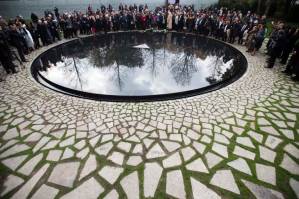Germany finally commemorates Roma Victims of the Holocaust

The monument is a round reflecting pool surrounded by flat stone slabs. Some of the slabs are engraved with the names of Nazi concentration and death camps.
Photos from Spiegel
By Alexandra Hudson
(Reuters) - Punches still fly in the Berlin boxing ring where Johann "Rukeli" Trollmann once trained before the Nazis stripped him of his German light-heavyweight title and excluded him from boxing because of his "gypsy blood".
Recognition for Trollmann, battered to death aged 36 in Neuengamme concentration camp in 1944, has been slow in coming, as it has been in general for the half a million ethnic Sinti and Roma murdered by the Nazis on racial grounds.
But Chancellor Angela Merkel will finally open a much-delayed memorial to Roma victims of the Nazi regime on Wednesday. Situated by parliament, it is meant to both commemorate the dead and stress the need to protect the living from hate and prejudice.
"We hope politicians, also those visiting from elsewhere, will see this monument and remember the urgent need to take a stand, " said Romani Rose, head of the German Council of Sinti and Roma.
The European Commission says many of Europe’s 12 million Roma face discrimination and social exclusion, often living in dire poverty. Economic crisis has made this worse in some countries: Hungary’s far-right Jobbik party called for zero-tolerance against what it called Roma "crime and parasitism".
A program of events will run in parallel to the opening of the memorial, highlighting Sinti and Roma life in Germany, such as a display by young boxers, among them a new generation of German Sinti, inspired and moved by Trollmann’s fate.
Sinti, the name used by ethnic Roma based in Germany for centuries, saw discrimination increase at alarming levels once Adolf Hitler took power in 1933. They were sent to forced labor camps, and from 1934 subjected to forced sterilization as a result of the Nazis’ "racial purity" laws.
By the start of World War Two, the Nazis’ genocidal intent became clear as Sinti and Roma were deported to death camps, where they wore uniforms bearing a "Z" for "Zigeuner" (gypsy.)
"GYPSY BOXER"
Trollmann was a promising young fighter when Hitler came to power and to the Nazis’ horror beat reigning German light-heavyweight champion Adolf Witt in June 1933. Boxing authorities tried to rule the fight invalid, but bowed to an angry crowd who had been thrilled by the dashing and nimble boxer.
Just days later they found an excuse to strip him of his title regardless, and challenged him, under pain of losing his license, to a "proper German fight" where he would be banned from "dancing about like a gypsy".
Trollmann arrived for the fight in Berlin with his skin painted white and his hair bleached blonde to protest against the very idea of such a fight. Forced to abandon his nimble footwork and effectively remain rooted to the spot trading punches with his opponent, he collapsed after five rounds.
It was his last official boxing match. Several years later he was sent to a concentration camp.
His title was reinstated in 2003, and his story is only today being retold.
"Prejudice still exists. When people ask where I’m from, I say I’m a Sinto, a gypsy, then I see how their interest immediately drops, " said Josef Klimt, a 21-year-old boxer from Gelsenkirchen, whose grandparents all survived concentration camps. "Trollmann’s story is very sad, very moving."
"You have to learn how to struggle, to pick yourself up if you fall and live with discipline, " said Sinto boxing instructor Robert Marschall, himself a former West German champion.
"Otherwise as a Sinto you are lost from the very start."
Watching the boxing display was Trollmann’s 77-year-old daughter Rita. She never knew her father, as he left his non-Sinto family in order to spare them the persecution he faced.
With the opening of the monument in Berlin - a circular pool of water with a flower on a small plinth in the middle - comes an end to a 20-year struggle by the Council of Sinti and Roma for a central memorial. The project has been hit by disputes about the inscription on the monument and how it should look.
"For many years our victims of the Holocaust were only mentioned as an aside. Sinti and Roma were left to remember and come to terms with their suffering alone, " said Rose.
The first time a German leader recognized Nazi persecution of the Roma on racist grounds was in 1982, more than 30 years after the then West Germany acknowledged the murder of 6 million Jews and began to pay compensation to Israel.
"I’m grateful we now have this monument, " Rose said.
"Visitors will have the chance to learn about the murder of our people, and contemplate at this spot."
(Edited by Stephen Brown and Andrew Osborn)






